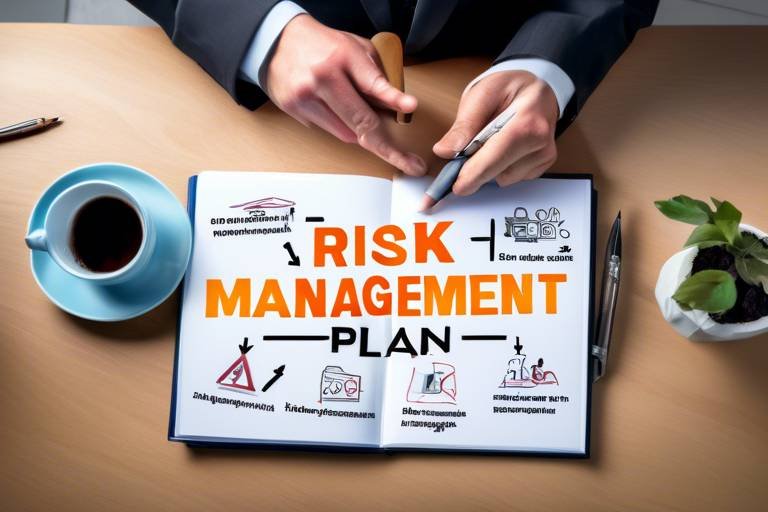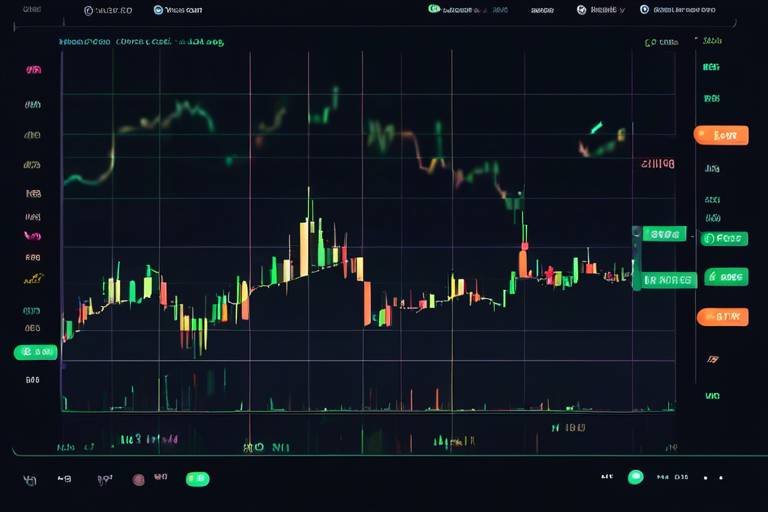How to Develop a Comprehensive Risk Management Plan
Creating a comprehensive risk management plan is not just a box-ticking exercise; it’s a crucial strategy that can mean the difference between success and failure in any organization. Imagine embarking on a journey without a map or GPS—sounds risky, right? That’s precisely how organizations operate without a robust risk management plan. This article outlines the essential components and steps needed to create an effective risk management plan, ensuring organizations can identify, assess, and mitigate potential risks to achieve their objectives.
Risk management is the process of identifying, assessing, and prioritizing risks followed by coordinated efforts to minimize, monitor, and control the probability or impact of unfortunate events. Think of it as a safety net that catches you before you fall. The goal is to provide a structured approach to managing uncertainty while ensuring that the organization can meet its objectives. A well-crafted risk management plan not only protects resources but also enhances decision-making and boosts stakeholder confidence.
The first step in risk management involves recognizing potential risks that could affect the project or organization. These risks can be financial, operational, strategic, or compliance-related. Identifying risks is like playing detective—you need to look closely at every aspect of your organization to uncover what could go wrong. Consider the following categories of risks that you might encounter:
- Financial Risks: These are related to the financial health of the organization, including cash flow issues and market fluctuations.
- Operational Risks: These stem from internal processes, systems, or human error that can disrupt operations.
- Strategic Risks: These involve risks that could impact the long-term goals and strategies of the organization.
- Compliance Risks: These relate to the legal and regulatory requirements that organizations must adhere to.
Different types of risks can impact an organization, including market risks, credit risks, operational risks, and reputational risks, each requiring distinct strategies for identification and management. Let’s explore a couple of these in detail:
Market risks refer to potential losses due to changes in market conditions, such as fluctuations in prices, interest rates, or foreign exchange rates. For example, a sudden increase in interest rates can significantly affect an organization’s borrowing costs, leading to reduced profitability. It’s crucial to stay ahead of these changes through continuous market analysis.
Operational risks arise from inadequate or failed internal processes, people, and systems, or from external events. Imagine a manufacturing plant that experiences a machinery breakdown—this can halt production and lead to significant losses. Identifying these risks early can help organizations implement preventive measures.
Once risks are identified, various assessment techniques can be employed to evaluate their potential impact and likelihood, enabling organizations to prioritize their risk management efforts. Techniques such as qualitative assessments, quantitative assessments, and risk matrices can be used to gauge the severity of each risk. This step is crucial because it helps organizations focus their resources on the most pressing threats.
A risk response plan outlines the strategies to mitigate identified risks, detailing actions to reduce the likelihood or impact of each risk. This plan is your action blueprint. Think of it as your game plan before a big match; it prepares you for different scenarios. The strategies can include:
- Risk Avoidance: Changing plans to sidestep the risk altogether.
- Risk Reduction: Taking steps to reduce the impact or likelihood of the risk.
- Risk Sharing: Spreading the risk across other parties, such as through outsourcing.
- Risk Acceptance: Acknowledging the risk and preparing to deal with its consequences.
Continuous monitoring and review of the risk management plan are essential to ensure its effectiveness and to adapt to any changes in the risk environment. This is not a one-time task; it’s an ongoing process. Regular reviews can help identify new risks and assess the effectiveness of current strategies, ensuring that the organization remains resilient.
Effective communication of the risk management plan to all stakeholders is crucial for ensuring understanding, engagement, and compliance with the established strategies. It’s like sharing the rules of a game; everyone needs to know how to play their part. Regular updates and training sessions can foster a culture of risk awareness within the organization.
Training staff on risk management principles and practices fosters a risk-aware culture within the organization, enhancing the effectiveness of the risk management plan. When everyone understands the importance of risk management, they become more vigilant and proactive in identifying potential threats.
In conclusion, a comprehensive risk management plan is vital for organizational success. It prepares you to face potential challenges while achieving strategic objectives. By taking the necessary steps to develop and implement this plan, you ensure that your organization is not only prepared for the unexpected but also positioned for growth and success.
Q: What is the first step in developing a risk management plan?
A: The first step is to identify potential risks that could impact the organization.
Q: Why is risk assessment important?
A: Risk assessment helps prioritize risks based on their potential impact and likelihood, allowing organizations to focus their resources effectively.
Q: How often should a risk management plan be reviewed?
A: It should be reviewed regularly, as risks can change over time due to internal and external factors.

Understanding Risk Management
Risk management is not just a buzzword thrown around in corporate boardrooms; it’s a critical process that can make or break an organization. At its core, risk management is about identifying, assessing, and prioritizing risks that could derail your objectives. Think of it as a safety net that helps you navigate through the turbulent waters of business. Without a solid risk management plan, you’re essentially sailing a ship without a compass, vulnerable to the unpredictable storms that may come your way.
So, what exactly does the risk management process entail? It begins with identifying potential risks. These could range from financial pitfalls to operational hiccups, strategic misalignments, or compliance failures. Once you’ve identified these risks, the next step is to assess their likelihood and potential impact. This assessment allows you to prioritize which risks need immediate attention and which can be monitored over time.
To illustrate, let’s break down the risk management process into its key components:
| Component | Description |
|---|---|
| Identification | Recognizing potential risks that could impact the organization. |
| Assessment | Evaluating the likelihood and impact of identified risks. |
| Response Planning | Developing strategies to mitigate or manage risks. |
| Monitoring | Continuously reviewing and updating the risk management plan. |
Once you have a clear understanding of the risks, you can begin to formulate strategies to address them. This is where the magic happens! By proactively managing risks, you not only protect your organization from potential threats but also position it for growth and success. Imagine walking through a dense forest without a map; risk management is your guide, ensuring you don’t get lost or encounter unexpected dangers.
In essence, understanding risk management is about being prepared. It's about asking yourself, “What could go wrong?” and then taking the necessary steps to either prevent those issues or minimize their impact. This proactive approach not only enhances your organization’s resilience but also fosters a culture of awareness and accountability among your team.
As you delve deeper into the world of risk management, keep in mind that it’s not a one-time effort. The landscape of risks is ever-changing, and your strategies need to evolve accordingly. Regular training and updates are essential to ensure that everyone in your organization is on the same page when it comes to managing risks effectively.

Identifying Risks
Identifying risks is the cornerstone of any effective risk management plan. It's like being a detective, searching for clues that could lead to potential pitfalls in your organization or project. The first step in this process is to recognize the various types of risks that could rear their ugly heads. These can range from financial setbacks and operational hiccups to strategic missteps and compliance failures. Each risk has its own unique fingerprint, and understanding these nuances is crucial for success.
To kick off the identification process, you might want to gather a diverse team that includes members from different departments. Why? Because risks can lurk in every corner of an organization. A finance expert might spot a financial risk that a marketing guru overlooks, while an IT specialist could pinpoint operational risks that others might not consider. Collaborating across departments not only enriches the identification process but also fosters a culture of shared responsibility towards risk management.
Now, let’s delve into some specific categories of risks that organizations often encounter:
- Financial Risks: These involve potential losses due to budget overruns, unexpected expenses, or changes in market conditions that could affect revenue.
- Operational Risks: These arise from internal processes, people, or systems failing, or from external events that disrupt operations.
- Strategic Risks: These are associated with the long-term goals of an organization and can come from shifts in market dynamics, competitive pressures, or changing consumer preferences.
- Compliance Risks: These stem from violations of laws, regulations, or internal policies, which can lead to legal penalties and damage to reputation.
Once you’ve got a handle on the types of risks, it’s time to employ various techniques for identifying them. This could include brainstorming sessions, surveys, or even risk workshops where team members can voice their concerns and insights. Another effective approach is to conduct a SWOT analysis (Strengths, Weaknesses, Opportunities, Threats). This method not only helps in identifying risks but also highlights areas where your organization can thrive despite potential challenges.
In addition, it’s essential to review historical data and past incidents within your organization. Reflecting on previous projects can provide invaluable insights into what went wrong and how similar risks can be mitigated in the future. By learning from past experiences, you can build a more resilient organization that is better prepared for whatever challenges may come its way.
In conclusion, identifying risks is not a one-time activity; it’s an ongoing process that requires vigilance and adaptability. As your organization evolves, so too will the risks it faces. Therefore, regular reviews and updates to your risk identification strategies are crucial to ensure that nothing slips through the cracks. Remember, the earlier you identify a potential risk, the better equipped you are to manage it effectively.
Q1: What are the main types of risks organizations should consider?
A1: Organizations should consider various types of risks including financial, operational, strategic, and compliance risks, as each can significantly impact their objectives.
Q2: How can teams effectively identify risks?
A2: Teams can effectively identify risks through brainstorming sessions, surveys, SWOT analyses, and reviewing historical data to uncover potential pitfalls.
Q3: Is risk identification a one-time process?
A3: No, risk identification is an ongoing process that should be regularly reviewed and updated as the organization evolves and new risks emerge.

Types of Risks
When it comes to risk management, understanding the different types of risks is crucial for any organization. Each type poses unique challenges and requires tailored strategies for effective management. Broadly speaking, risks can be categorized into four main types: market risks, credit risks, operational risks, and reputational risks. By identifying these risks, organizations can develop specific plans to mitigate their impacts.
Market risks are often the most visible and can significantly affect an organization's financial performance. These risks arise from fluctuations in market conditions, such as changes in prices, interest rates, or foreign exchange rates. For instance, a sudden drop in stock prices can lead to substantial losses for investors. Companies operating in international markets must also be aware of currency risk, which can affect profitability depending on exchange rate movements.
Next, we have credit risks, which involve the possibility that a borrower will default on a loan or fail to meet contractual obligations. This type of risk is particularly relevant for financial institutions, as it can directly affect their bottom line. Organizations must assess the creditworthiness of clients and partners to minimize potential losses. Implementing strict credit policies and conducting thorough due diligence can help in managing this risk effectively.
Operational risks stem from internal processes, people, and systems. They can also arise from external events that disrupt normal operations. For example, a manufacturing company might face operational risks due to equipment failure, supply chain disruptions, or even cyber-attacks. To combat these risks, organizations need to establish robust systems and processes, ensuring that they can respond swiftly to any disruptions.
Finally, reputational risks can have far-reaching consequences for an organization. These risks arise when negative publicity or events tarnish the reputation of a company, leading to a loss of customer trust and loyalty. In today’s digital age, where news spreads rapidly through social media, managing reputational risks has become more critical than ever. Organizations must proactively engage with their stakeholders and maintain transparency to safeguard their reputation.
In summary, understanding the various types of risks is vital for effective risk management. Each category requires distinct strategies and attention to ensure that organizations can navigate the complexities of their operational environments. By being proactive and prepared, companies can mitigate these risks and position themselves for long-term success.

Market Risks
Market risks are a significant concern for any organization operating in today's dynamic business environment. These risks arise from fluctuations in market conditions that can adversely affect an organization's financial performance. Imagine you're on a roller coaster; just as you think you're on a smooth ride, a sudden drop can catch you off guard. Similarly, market risks can lead to unexpected financial losses, making it crucial for businesses to understand and manage them effectively.
Market risks can manifest in several ways, including:
- Price Fluctuations: Changes in the prices of goods and services can impact revenue and profitability.
- Interest Rate Changes: Variations in interest rates can influence borrowing costs and investment returns.
- Foreign Exchange Rate Movements: For companies dealing in international markets, shifts in currency values can significantly affect profits.
To illustrate the impact of market risks, consider a company that exports goods. If the value of the dollar increases against other currencies, their products may become more expensive for foreign buyers, potentially leading to a decline in sales. Conversely, if interest rates rise, the cost of financing operations may increase, squeezing profit margins further. This interconnectedness of market factors means that organizations must continuously monitor and analyze market trends to anticipate potential risks.
Furthermore, organizations can employ various strategies to mitigate market risks, such as diversifying their product offerings, hedging against currency fluctuations, or adjusting their pricing strategies in response to market conditions. By understanding the nature of these risks and implementing effective strategies, businesses can navigate the turbulent waters of the market more successfully.
In summary, market risks are not just abstract concepts; they are real challenges that can impact an organization's bottom line. By being proactive and developing a robust risk management framework, organizations can position themselves to weather the storms of market volatility and emerge stronger on the other side.
- What are the main types of market risks? Market risks primarily include price fluctuations, interest rate changes, and foreign exchange rate movements.
- How can organizations mitigate market risks? Organizations can mitigate market risks through diversification, hedging strategies, and responsive pricing adjustments.
- Why is it important to monitor market risks continuously? Continuous monitoring allows organizations to anticipate changes and adapt their strategies accordingly, reducing potential financial losses.

Operational Risks
Operational risks are those pesky little gremlins that can wreak havoc on an organization’s daily functions. They arise from a variety of sources, including internal processes, human errors, and even external events. Imagine running a well-oiled machine, and then suddenly, a cog gets stuck—that's operational risk in action. It can stem from things like inadequate processes, system failures, or even the unexpected absence of key personnel. But don’t worry; understanding these risks is the first step toward managing them.
To give you a clearer picture, here are some common sources of operational risks:
- Process Failures: These occur when internal procedures are not followed correctly, leading to inefficiencies or errors.
- Technology Failures: When systems crash or software malfunctions, it can halt operations and cause significant financial loss.
- Human Factors: Mistakes made by employees, whether due to lack of training or oversight, can have serious repercussions.
- External Events: Natural disasters, cyberattacks, or even supply chain disruptions can impact operational efficiency.
Operational risks can be particularly challenging because they often result in financial losses, damage to reputation, and even legal liabilities. For instance, if an organization fails to comply with regulations due to an operational oversight, it may face hefty fines and damage to its credibility. The key is to identify these risks early and implement strategies that not only mitigate their impact but also enhance the overall resilience of the organization.
One effective way to manage operational risks is through the development of a robust risk management framework. This framework should include regular risk assessments, where potential operational risks are identified and analyzed. By doing so, organizations can prioritize which risks need immediate attention and which can be monitored over time. Additionally, fostering a culture of accountability and communication within the organization can significantly reduce the likelihood of operational risks manifesting into larger issues.
In conclusion, operational risks are an inevitable part of any business landscape. However, with a proactive approach, organizations can navigate these challenges effectively. By understanding the sources of operational risks and implementing a comprehensive risk management strategy, businesses can not only protect themselves from potential losses but also pave the way for sustainable growth and success.
- What are operational risks? Operational risks are risks arising from internal processes, people, systems, or external events that can disrupt an organization’s operations.
- How can organizations mitigate operational risks? Organizations can mitigate operational risks through regular risk assessments, employee training, and developing strong internal processes and systems.
- Why is it important to manage operational risks? Managing operational risks is crucial to prevent financial losses, protect the organization’s reputation, and ensure compliance with regulations.
- What role does technology play in operational risk management? Technology can help automate processes, enhance communication, and provide tools for monitoring and assessing risks more effectively.

Risk Assessment Techniques
Once you've identified potential risks, the next crucial step in the risk management process is to assess these risks effectively. This is where the magic happens! Risk assessment techniques allow organizations to evaluate the potential impact and likelihood of each identified risk, helping to prioritize which risks need immediate attention. Think of it as a doctor diagnosing a patient; you need to understand the severity of each symptom before deciding on a treatment plan. In the world of risk management, this means categorizing risks based on their likelihood of occurrence and the potential damage they could cause.
There are several techniques that organizations can employ to assess risks, each with its unique approach and benefits. Here are some of the most commonly used techniques:
- Qualitative Risk Assessment: This technique involves subjective judgment and is often used for risks that are difficult to quantify. It focuses on the experience and intuition of team members to categorize risks as high, medium, or low based on their potential impact and likelihood.
- Quantitative Risk Assessment: Unlike qualitative methods, quantitative assessments rely on numerical data and statistical analysis. This approach is ideal for risks that can be measured, as it provides a more objective view of the risks involved.
- Risk Matrix: A risk matrix is a visual tool that helps in plotting risks based on their likelihood and impact. This tool allows teams to quickly identify which risks require more attention and resources.
- SWOT Analysis: This technique evaluates the Strengths, Weaknesses, Opportunities, and Threats related to a project or organization. It’s a great way to understand internal and external factors that could impact risk levels.
Utilizing these techniques can help organizations not only to understand the risks they face but also to develop a clear strategy for addressing them. For instance, a risk matrix can be particularly useful in visualizing how various risks stack up against one another, providing a clear picture of which risks are the most pressing. This way, organizations can allocate resources efficiently and ensure that they are addressing the most critical risks first.
Additionally, it’s essential to engage stakeholders during the risk assessment process. Their insights can provide valuable context and help in identifying risks that may not have been immediately apparent. After all, two (or more) heads are better than one! By collaborating with team members across various departments, organizations can create a more comprehensive risk profile and ensure that all potential risks are considered.
In summary, effective risk assessment techniques are vital for prioritizing risks and developing an effective risk management strategy. By employing a mix of qualitative and quantitative methods, organizations can gain a robust understanding of their risk landscape and prepare accordingly.
What is the difference between qualitative and quantitative risk assessment?
Qualitative risk assessment relies on subjective judgment and categorizes risks based on their potential impact and likelihood, while quantitative risk assessment uses numerical data and statistical analysis to provide an objective view of risks.
How can a risk matrix help in risk assessment?
A risk matrix visually plots risks based on their likelihood and impact, enabling organizations to quickly identify which risks require more attention and resources.
Why is stakeholder involvement important in risk assessment?
Engaging stakeholders during the risk assessment process provides valuable insights and helps identify risks that may not be immediately apparent, leading to a more comprehensive risk profile.

Developing a Risk Response Plan
Creating a risk response plan is like crafting a safety net for your organization; it ensures that when potential risks loom on the horizon, you are not left scrambling for solutions. A well-structured risk response plan outlines the strategies to mitigate identified risks, detailing specific actions that can either reduce the likelihood of these risks occurring or lessen their impact should they materialize. Think of it as your organization’s emergency manual, guiding you through turbulent times with clarity and purpose.
To develop a robust risk response plan, start by categorizing the identified risks based on their severity and potential impact. This categorization allows you to prioritize which risks require immediate attention and which ones can be monitored over time. For instance, a risk that could lead to significant financial loss should be addressed more urgently than a minor operational hiccup. By focusing on the most critical threats first, you can allocate resources more effectively and ensure that your team is prepared to tackle the biggest challenges.
Next, it's essential to outline specific mitigation strategies for each identified risk. These strategies can take various forms, including:
- Risk Avoidance: Altering plans to sidestep potential risks altogether.
- Risk Reduction: Implementing measures to reduce the likelihood or impact of the risk.
- Risk Sharing: Transferring the risk to another party, such as through insurance or outsourcing.
- Risk Acceptance: Acknowledging the risk and deciding to proceed, often because the cost of mitigation is higher than the risk itself.
Each of these strategies can be tailored to fit your organization’s specific context and goals. For example, if your company faces a high risk of data breaches, you might choose to invest in robust cybersecurity measures (risk reduction) while also transferring some of that risk through cyber insurance (risk sharing). The key is to ensure that your strategies are not only effective but also feasible within your organization’s budget and resources.
Once you have established your mitigation strategies, it’s crucial to assign responsibilities. Who in your organization will implement these strategies? Assigning clear roles and responsibilities ensures accountability and helps to streamline the execution of your risk response plan. Consider creating a risk management team that regularly reviews and updates the plan as necessary, ensuring that it evolves alongside your organization.
Finally, don't forget the importance of communication. A risk response plan is only as effective as the understanding and buy-in of your entire team. Make sure to communicate the plan clearly and provide training if necessary. This way, everyone knows their role and the steps to take when faced with a risk, fostering a culture of preparedness.
Q1: What is the purpose of a risk response plan?
A risk response plan serves to outline strategies for mitigating identified risks, ensuring that an organization is prepared to handle potential challenges effectively.
Q2: How often should I review my risk response plan?
It’s advisable to review your risk response plan at least annually or whenever there are significant changes in your organization, such as new projects, market conditions, or regulatory requirements.
Q3: What should I do if a risk materializes despite having a plan?
If a risk materializes, refer to your risk response plan for the designated actions. Assess the situation, implement the planned response, and then conduct a review to learn from the incident and improve your plan.

Mitigation Strategies
When it comes to mitigating risks, having a well-thought-out strategy is like having a safety net beneath a tightrope walker. You want to ensure that if they slip, they have something to catch them before they hit the ground. In the world of risk management, mitigation strategies are the actions we take to reduce the likelihood or impact of potential risks. These strategies can be tailored to fit the specific nature of the risk and the overall goals of the organization.
One effective approach is risk avoidance, which involves changing plans to sidestep the risk altogether. Imagine a company that identifies a potential market downturn; instead of launching a new product that could fail, they might delay the launch until conditions are more favorable. This proactive approach can save resources and protect the organization from unnecessary losses.
Another strategy is risk reduction, which focuses on minimizing the impact or likelihood of the risk. This might involve implementing new processes, investing in technology, or enhancing employee training. For instance, a manufacturing company may invest in better machinery to reduce the risk of operational failures. By doing so, they not only improve efficiency but also significantly cut down on the chances of costly downtime.
Then there’s risk sharing, which is akin to pooling resources. This strategy involves distributing the risk across multiple parties. For example, a construction company might partner with an insurance provider to share the financial burden of potential accidents on-site. By doing this, they can alleviate some of the financial pressures and ensure that they have support if something goes wrong.
Lastly, there’s the option of risk acceptance. Sometimes, the cost of mitigating a risk is greater than the potential impact of the risk itself. In such cases, organizations may choose to accept the risk, knowing they have the capacity to manage any consequences. For example, a tech startup might accept the risk of fluctuating market demand because they believe their innovative product will ultimately succeed.
In summary, the choice of mitigation strategy depends on a variety of factors, including the nature of the risk, the resources available, and the organization's overall objectives. A well-rounded approach often combines several strategies to create a robust risk management framework. By understanding and implementing these strategies, organizations can navigate the unpredictable waters of business with greater confidence and resilience.
- What is the purpose of a risk management plan?
The purpose of a risk management plan is to identify, assess, and prioritize risks to minimize their impact on an organization's objectives. - How often should a risk management plan be reviewed?
A risk management plan should be reviewed regularly, at least annually, or whenever significant changes occur in the organization or its environment. - What are the key components of a risk management plan?
Key components include risk identification, risk assessment, risk response strategies, and monitoring and review processes. - How can organizations foster a risk-aware culture?
Organizations can foster a risk-aware culture through training and awareness programs that educate employees about risk management principles and practices.

Monitoring and Review
Monitoring and reviewing your risk management plan is not just a checkbox exercise; it's a vital component of ensuring your organization's resilience. Think of it as a lighthouse guiding a ship through turbulent waters—without it, you're sailing blind. Regularly assessing your risk management strategies allows you to adapt to new challenges and changes in the external environment, ensuring that you remain on course toward your objectives.
To effectively monitor the risks, organizations should establish a systematic approach that includes both qualitative and quantitative measures. This means not only tracking the data but also understanding the context behind it. For instance, if you notice a spike in operational risks due to new technology implementation, it’s essential to analyze the root causes rather than just acknowledging the increase.
One effective way to keep your finger on the pulse of risk is through key risk indicators (KRIs). These are specific metrics that help you gauge the level of risk exposure. Consider setting up a
| Key Risk Indicator | Description | Threshold | Current Status |
|---|---|---|---|
| Operational Downtime | Measures the amount of time operations are halted | Less than 2 hours/month | 1 hour |
| Compliance Violations | Tracks the number of compliance issues reported | Zero violations | 1 violation |
| Market Fluctuations | Monitors significant changes in market conditions | Less than 5% change | 3% change |
Moreover, it’s crucial to conduct regular reviews of your risk management plan. This could be quarterly or bi-annually, depending on your organization’s needs. During these reviews, gather feedback from various stakeholders to ensure that the plan remains relevant and effective. Engaging different perspectives not only enriches the review process but also fosters a culture of collaboration and transparency.
Finally, don’t forget to document all findings and adjustments made during the monitoring and review process. This documentation serves as a valuable resource for future reference and can help in refining your approach as new risks emerge. Continuous improvement is the name of the game, and by being proactive, you can turn potential threats into opportunities.
- What is the purpose of monitoring in risk management? Monitoring helps organizations track their risk exposure and adapt their strategies as needed.
- How often should a risk management plan be reviewed? It’s recommended to review the plan at least quarterly, but the frequency may vary based on the organization's specific needs.
- What are key risk indicators (KRIs)? KRIs are metrics used to measure potential risk exposure and help organizations assess their risk management effectiveness.
- Why is stakeholder feedback important in the review process? Stakeholder feedback provides diverse perspectives, enhancing the relevance and effectiveness of the risk management plan.

Communicating the Risk Management Plan
Effective communication of the risk management plan is not just a procedural step; it’s a vital component that can make or break the success of your risk management efforts. Think of it like a roadmap: if no one knows how to read it, how can they expect to reach their destination safely? When all stakeholders are on the same page, the organization can respond to risks more swiftly and efficiently.
To ensure that the risk management plan is understood and embraced by everyone involved, consider implementing a multi-faceted communication strategy. This strategy should include regular updates, workshops, and easy-to-read documentation. Here are some key aspects to focus on:
- Clarity: Use clear and straightforward language. Avoid jargon that might confuse stakeholders who are not familiar with risk management terminology.
- Engagement: Encourage feedback and discussions. When stakeholders feel their input is valued, they are more likely to engage with the plan actively.
- Accessibility: Ensure that the risk management documents are easily accessible. This could mean hosting them on a shared drive or intranet where everyone can find them.
Moreover, utilizing visual aids such as charts and infographics can significantly enhance understanding. For instance, a simple table can illustrate the various risks identified, their potential impacts, and the corresponding mitigation strategies. Here’s a quick example:
| Risk Type | Potential Impact | Mitigation Strategy |
|---|---|---|
| Market Risk | Loss of revenue due to price fluctuations | Diversification of product line |
| Operational Risk | Disruption in services | Implementing robust internal controls |
| Reputational Risk | Loss of customer trust | Proactive public relations strategies |
By regularly communicating updates and changes to the risk management plan, organizations can foster a culture of transparency and preparedness. This means not just sharing the plan at the outset but revisiting it frequently—especially after significant events or changes within the organization. Regular meetings and reports can help keep the momentum going and ensure that risk management remains a priority.
Ultimately, the goal of communicating the risk management plan is to create a shared understanding among all stakeholders. This shared understanding leads to a united front when facing potential challenges, enabling the organization to navigate risks with confidence and agility. Remember, a well-informed team is a powerful team!
- Why is communication important in risk management? Communication ensures that everyone understands the risks and the strategies in place to mitigate them, leading to better preparedness.
- How often should the risk management plan be communicated? It should be communicated regularly, especially after updates or changes, to keep all stakeholders informed.
- What methods can be used to communicate the plan? Methods can include meetings, emails, workshops, and visual aids like charts and infographics.

Training and Awareness
Training and awareness are the cornerstones of an effective risk management plan. Imagine trying to sail a ship through turbulent waters without a crew that understands the map and the weather patterns. That's what it feels like when an organization neglects to train its staff on risk management principles. It's not just about having a plan; it's about ensuring that everyone is on board and knows how to navigate potential risks. A well-informed team can spot issues before they escalate, acting like a well-tuned engine that keeps the organization running smoothly.
Incorporating training programs that focus on risk management can significantly enhance an organization's resilience. These programs should cover various aspects, including:
- Understanding Risk Types: Employees should be educated about different types of risks—financial, operational, strategic, and compliance—so they can recognize them in their daily activities.
- Risk Assessment Techniques: Teaching staff how to assess risks effectively empowers them to contribute to the organization’s risk management efforts.
- Response Strategies: Training should include how to implement risk mitigation strategies, ensuring that employees know what actions to take when a risk is identified.
Moreover, it’s essential to foster a culture of continuous learning. This can be achieved through regular workshops, seminars, and e-learning modules that keep the topic of risk management alive within the organization. Just like a garden needs constant care to flourish, a risk-aware culture needs ongoing attention and nurturing. Consider creating a feedback loop where employees can share their experiences and insights regarding risk management. This not only enhances knowledge but also empowers staff by making them feel valued and heard.
To illustrate the importance of training and awareness, let's take a look at a simple table that highlights the benefits of having a well-trained workforce:
| Benefit | Description |
|---|---|
| Increased Awareness | Employees become more vigilant and proactive in identifying risks. |
| Enhanced Decision-Making | Better understanding of risks leads to informed decision-making processes. |
| Improved Compliance | Staff who understand regulations are more likely to adhere to them. |
| Stronger Team Cohesion | A shared understanding of risks fosters teamwork and collaboration. |
In conclusion, investing in training and awareness is not just a good practice; it's a necessity for any organization that aims to thrive in a world full of uncertainties. By equipping your team with the knowledge and skills needed to manage risks effectively, you’re not only protecting your organization but also empowering your employees to take ownership of their roles in the risk management process.
- Why is training important for risk management? Training ensures that all employees understand the risks they face and how to mitigate them effectively.
- How often should risk management training be conducted? Regular training sessions, at least annually, are recommended to keep the information fresh and relevant.
- Can training improve compliance with regulations? Yes, well-informed employees are more likely to understand and adhere to compliance requirements.

Conclusion and Next Steps
In conclusion, developing a comprehensive risk management plan is not just a box-ticking exercise; it's a vital component of organizational success. By identifying, assessing, and prioritizing risks, organizations can not only safeguard their assets but also position themselves for growth and resilience in an ever-changing environment. Think of it as a safety net—one that allows you to take calculated risks while ensuring that you’re prepared for any potential falls.
As you embark on creating or refining your risk management plan, consider the following next steps:
- Engage Stakeholders: Involve key stakeholders from various departments to ensure diverse perspectives are considered.
- Regular Updates: Make it a habit to review and update the risk management plan regularly to reflect any changes in the business environment.
- Utilize Technology: Leverage risk management software to streamline the identification and assessment processes.
Remember, the goal is not to eliminate risks entirely but to manage them effectively. With a proactive approach, organizations can turn potential threats into opportunities for innovation and improvement. So, take these insights and start crafting a risk management strategy that not only protects but also empowers your organization to thrive.
1. What is the primary purpose of a risk management plan?
The primary purpose of a risk management plan is to identify potential risks and outline strategies to mitigate those risks, ensuring that an organization can achieve its objectives without unforeseen disruptions.
2. How often should a risk management plan be reviewed?
A risk management plan should be reviewed at least annually, but it’s advisable to revisit it more frequently, especially after significant changes in the organization or its operating environment.
3. Who should be involved in the risk management process?
Key stakeholders from various departments should be involved in the risk management process, including finance, operations, compliance, and executive leadership, to ensure a comprehensive approach.
4. What are some common risk assessment techniques?
Common risk assessment techniques include qualitative assessments (like interviews and surveys), quantitative analysis (like statistical modeling), and scenario analysis to evaluate the potential impact of risks.
5. Can technology help in risk management?
Absolutely! Technology can streamline the risk management process by providing tools for risk identification, assessment, and monitoring, making it easier to manage risks effectively.
Frequently Asked Questions
- What is a risk management plan?
A risk management plan is a structured approach that outlines how an organization will identify, assess, and manage potential risks that could impact its objectives. It serves as a roadmap to ensure that risks are systematically addressed and mitigated.
- Why is identifying risks important?
Identifying risks is crucial because it allows organizations to foresee potential challenges and vulnerabilities. By recognizing these risks early on, companies can take proactive measures to minimize their impact, ensuring smoother operations and better decision-making.
- What types of risks should be considered?
Organizations should consider various types of risks, including:
- Market Risks
- Operational Risks
- Financial Risks
- Compliance Risks
- Reputational Risks
Each type of risk requires different strategies for management and mitigation.
- How can risks be assessed?
Risks can be assessed using several techniques, such as qualitative and quantitative analysis. Qualitative assessments involve expert judgments and scenarios, while quantitative assessments use statistical methods to evaluate the likelihood and impact of risks, helping organizations prioritize their responses.
- What are some common risk mitigation strategies?
Common risk mitigation strategies include:
- Avoidance: Altering plans to sidestep potential risks.
- Reduction: Implementing measures to reduce the likelihood or impact of risks.
- Sharing: Transferring risk to another party, such as through insurance.
- Acceptance: Acknowledging the risk and preparing to manage its consequences if it occurs.
- How often should a risk management plan be reviewed?
A risk management plan should be reviewed regularly, at least annually, or whenever there are significant changes in the organization or its environment. Continuous monitoring ensures that the plan remains effective and relevant, adapting to new risks as they arise.
- Why is communication important in risk management?
Effective communication is vital because it ensures that all stakeholders understand the risk management plan and their roles within it. Clear communication fosters engagement and compliance, helping to create a culture of risk awareness throughout the organization.
- What role does training play in risk management?
Training plays a key role in fostering a risk-aware culture. By educating staff on risk management principles and practices, organizations empower employees to recognize and respond to risks effectively, enhancing the overall effectiveness of the risk management plan.



















